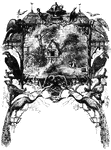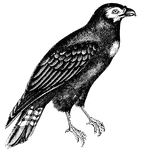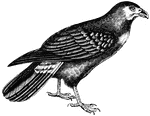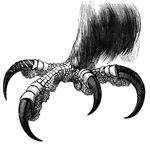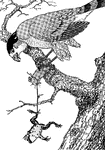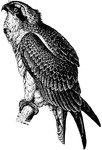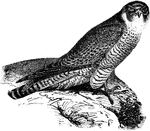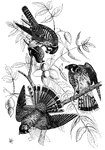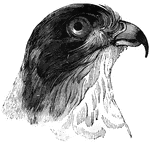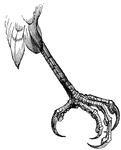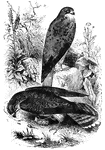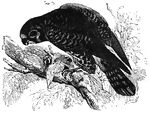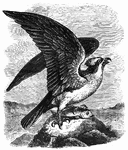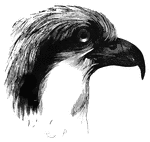Clipart tagged: ‘hawk’
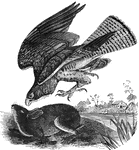
Common Buzzard of Europe
"B. vulgaris is twenty-two inches long, the head is large and the body heavy. Above, the color…
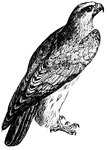
Falcon
Falcons are a group of birds of prey that vary in size from the falconet to the gyrefalcon. They can…
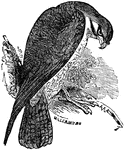
The Falcon
"The Falcon is a famous bird of prey. It is characterized by a bill curved from the base."
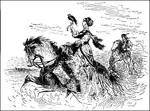
Falconry as Practiced by a Noblewoman of the Middle Ages on Horseback
A high-born, noblewoman rides a stallion while holding a falcon perched on her right hand. She is wearing…
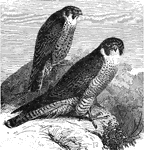
Two Peregrine Falcons
"Falco peregrinus. Peregrine Falcon. Duck Hawk. Great-footed Hawk. A medium-sized falcon, about as large…

Peregrine Falcon Small
"Falco peregrinus. Peregrine Falcon. Duck Hawk. Great-footed Hawk. A medium-sized falcon, about as large…
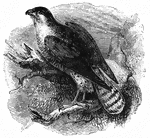
Goshawk
"The American goshawk &mdash the black-cap haw of Wilson &mdash A. atricapillus which has been…

Harrier Ear Parts
"Circinae. Harriers. Face surrounded with an incomplete ruff (as in most owls); orifice of ear about…

American Marsh Hawk
Also known as the American harrier, the marsh hawk (C. Hudsonius) is nineteen to twenty-one…
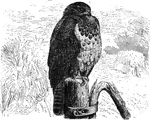
European Hawk
"Buteo vulgaris. hawk of Europe, Upper parts dark brown, very variable in shade according to season…

Marsh Hawk
A bird of the harriers, having an incomplete facial disk and large ear pars, as in some owls, a week…

Night Hawk
Found in America, Mexico and the West Indies, this species averages nine to ten inches in length and…
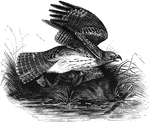
Red-Shouldered Hawk
Also known as the winter falcon, is found in California, Wisconsin, and South Carolina.
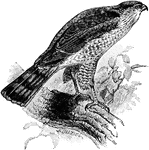
Sharp-Shinned Hawk
The adult female Sharp-Shinned Hawk (Accipiter striatus). The "Sharpie" is a small hawk in the Accipitridae…
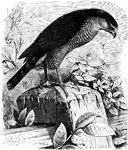
Sharp-shinned Hawk
"Accipiter fuscus. Sharp-shinned Hawk. "Pigeon" Hawk. Above, dark plumbeous, slate-color, or bluish-gray,…
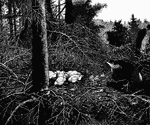
Two Sparrow Hawk in a Large Flat Nest of Twigs with Five Young Sparrow-Hawk Beside a Tree Trunk
"Accipiter nisus, the Sparrow-Hawk, which breeds throughout Europe, North Africa, Asia north of the…
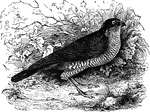
European Sparrowhawk
Resembles the American sparrow-hawk, feeding primarily on small birds and quadrupeds, as well as domesticated…

The Superficial Muscles of a Hawk
In birds the muscles system is remarkable for their marked line of attachment to their tendons. Labels:…
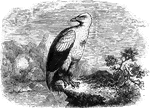
Vulture Hawk
Genus Gypohierax, is about the size of a goose, and is found in Western Africa, particularly…
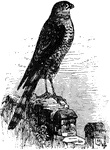
Sharp-shinned Hawk - Small
"Accipiter fuscus. Sharp-shinned Hawk. "Pigeon" Hawk. Above, dark plumbeous, slate-color, or bluish-gray,…

Hawking Glove
A glove used in the sport hawking, employed to protect ones hand and wrist from the talons and beak…
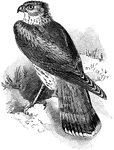
Merlin
"The letter C marks the point where the vessel to be exhausted is attached." -Century, 1889The Merlin…

Rio peddlers
"Nearly all the hucksters of Rio carry their vegetables, fruits, and fish from house to house on their…

